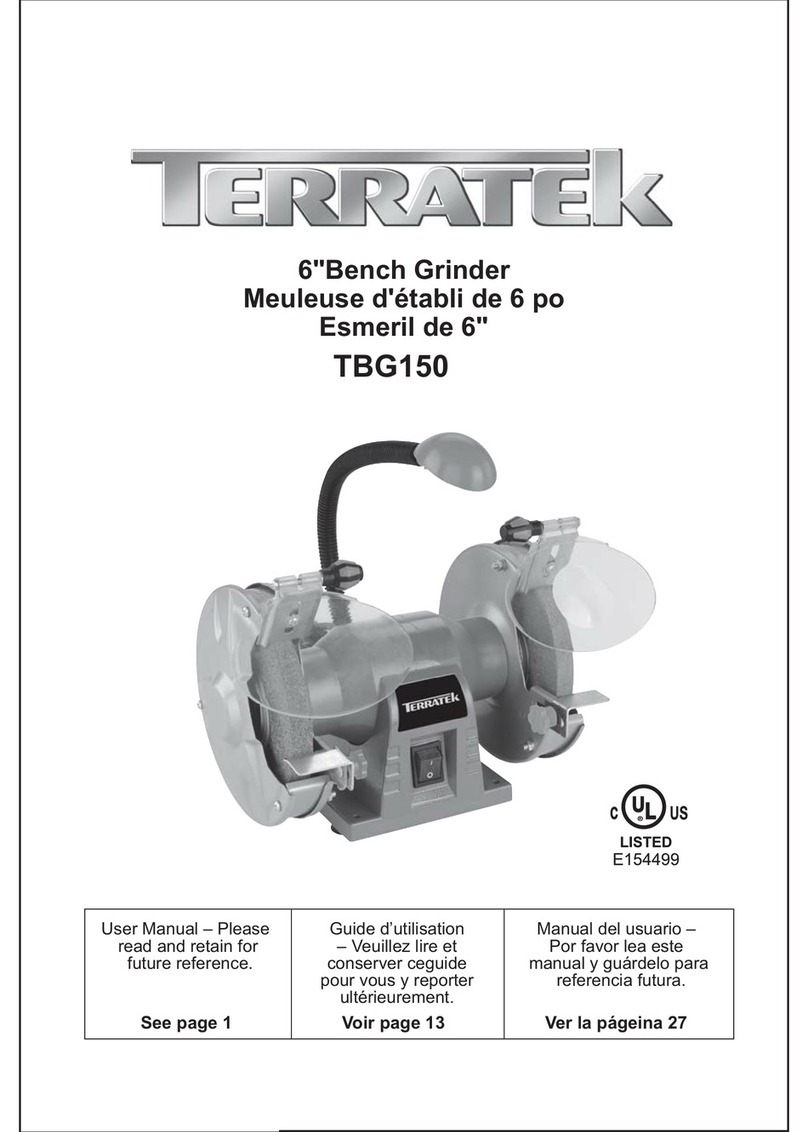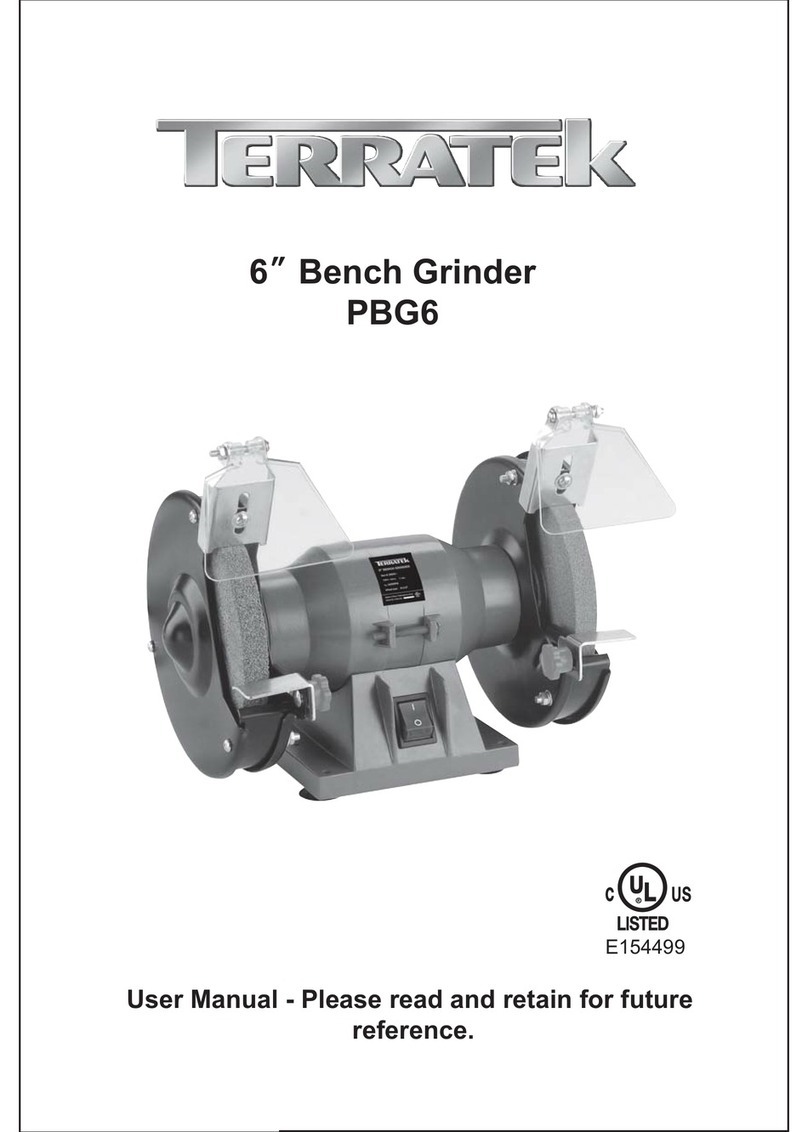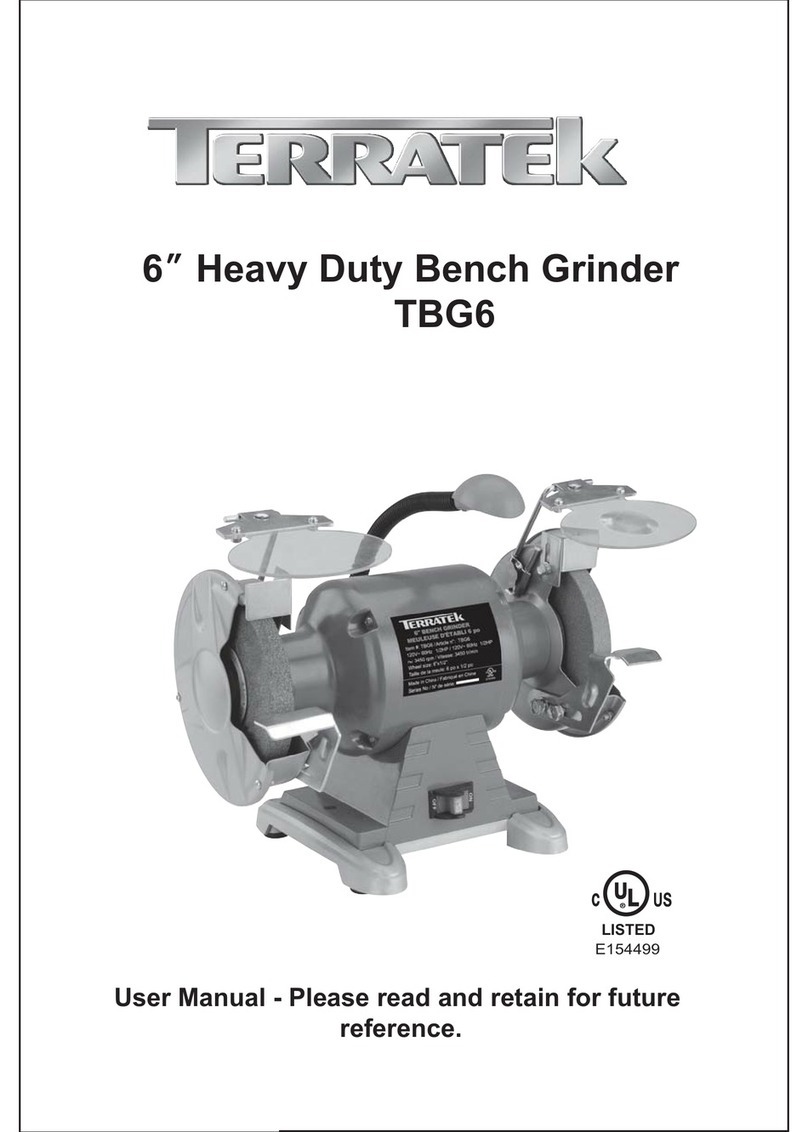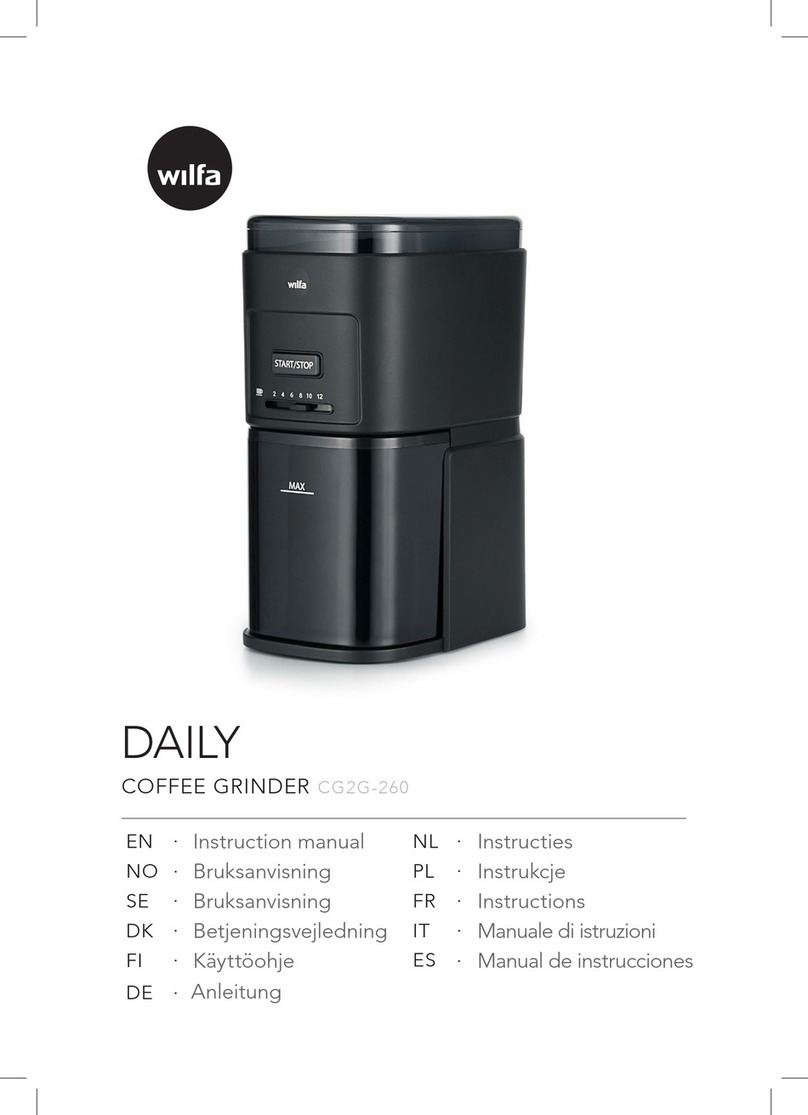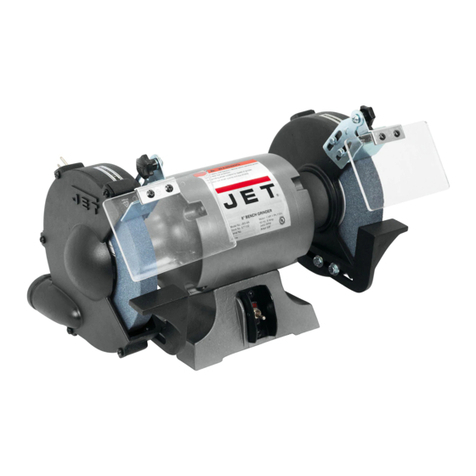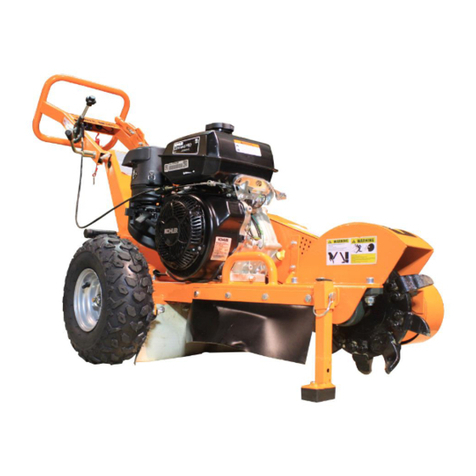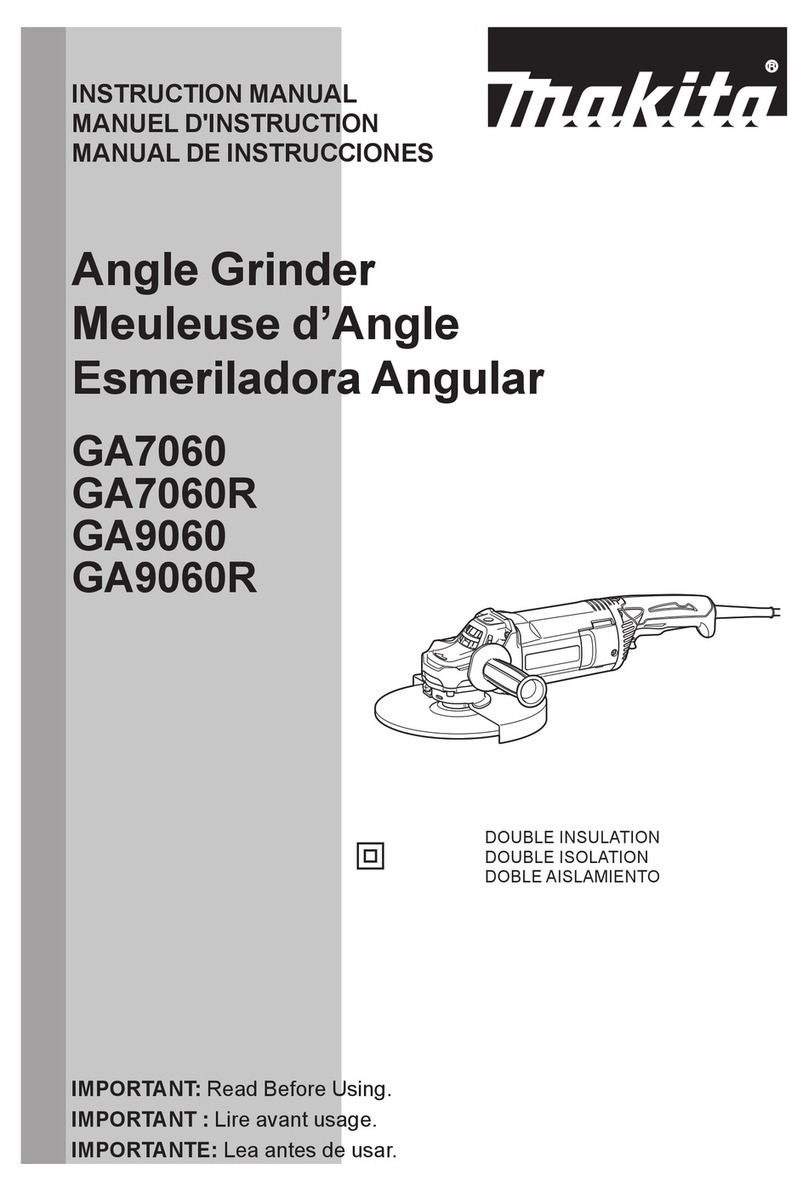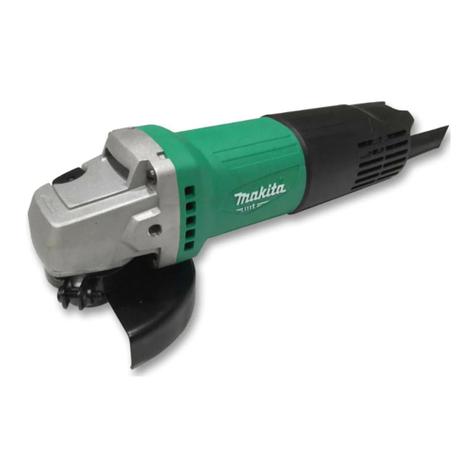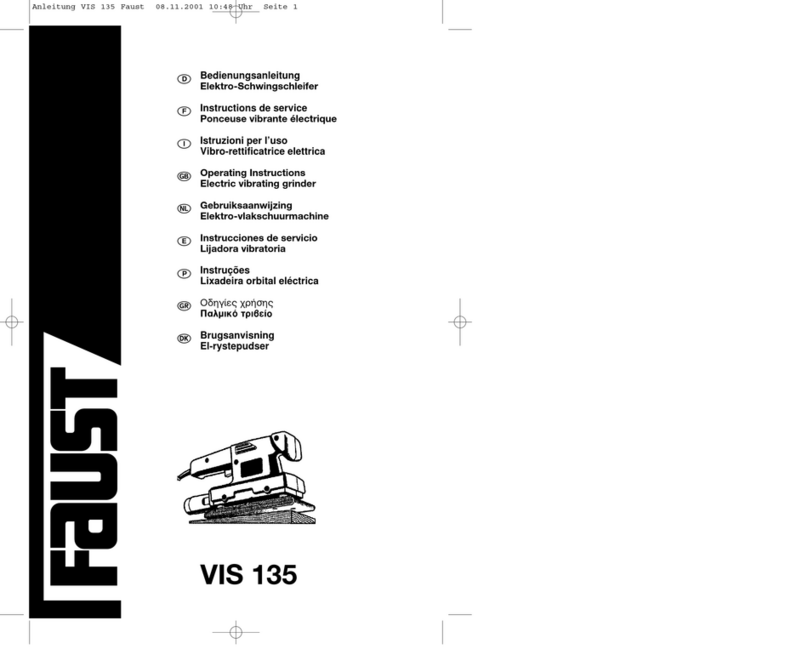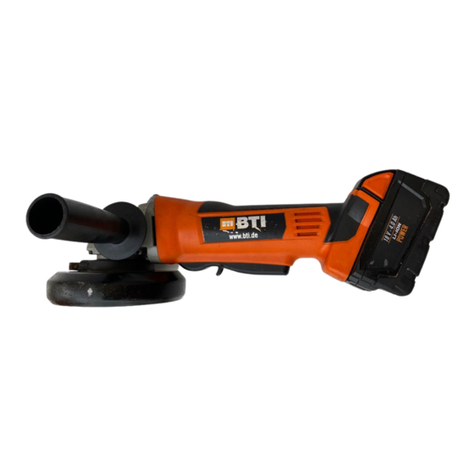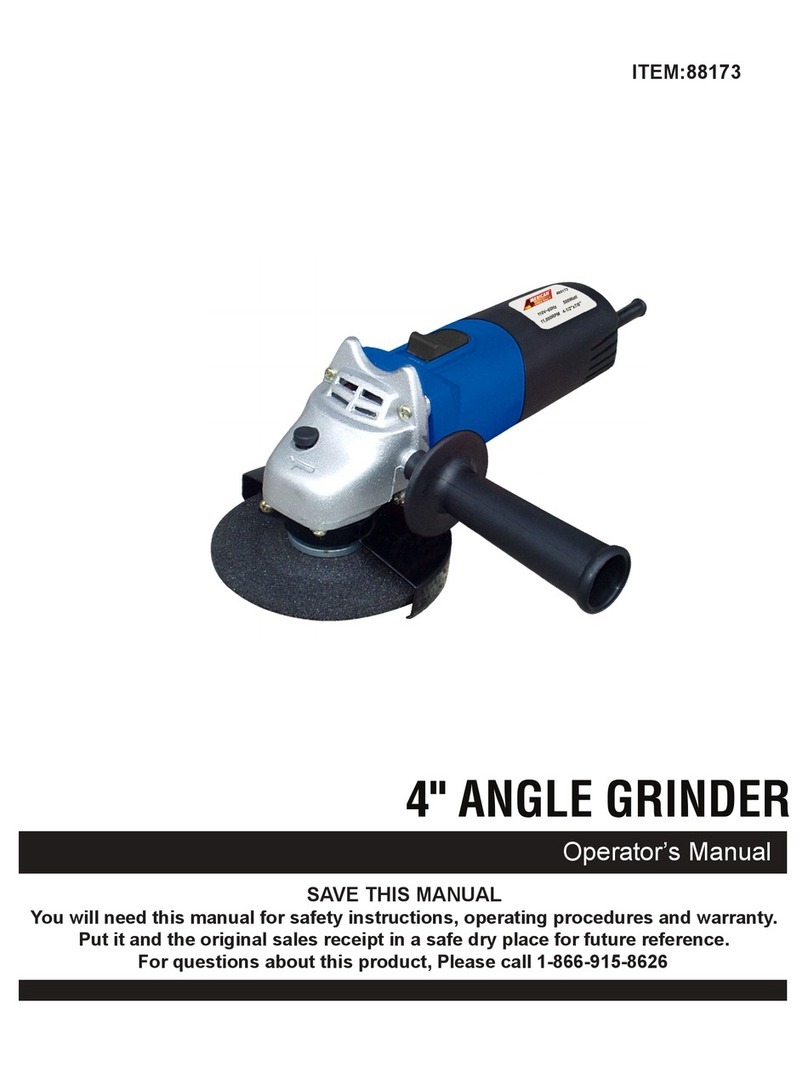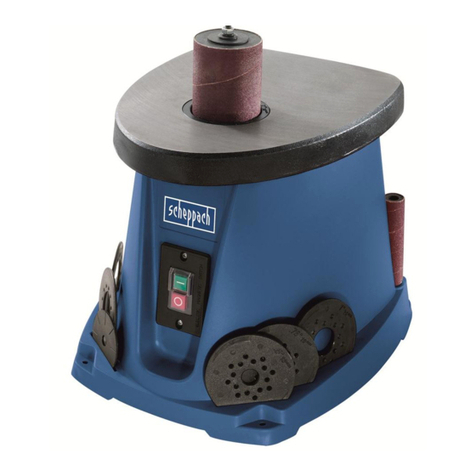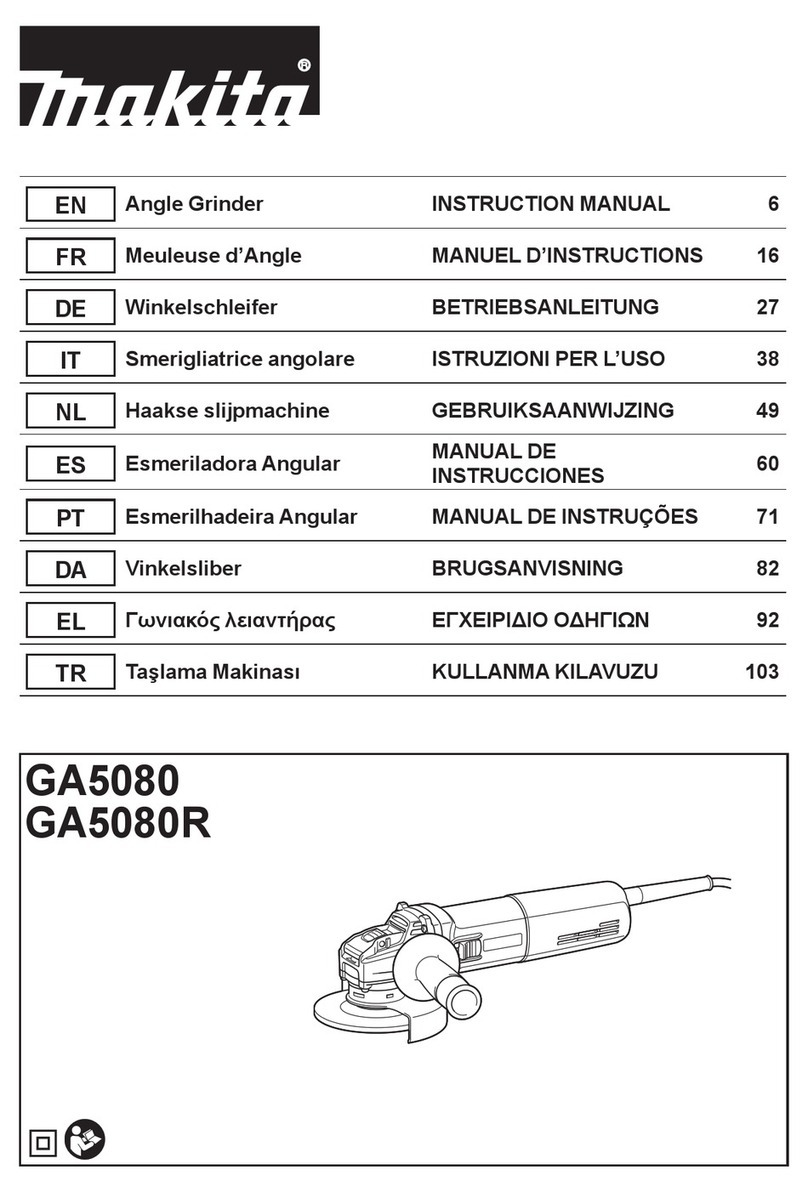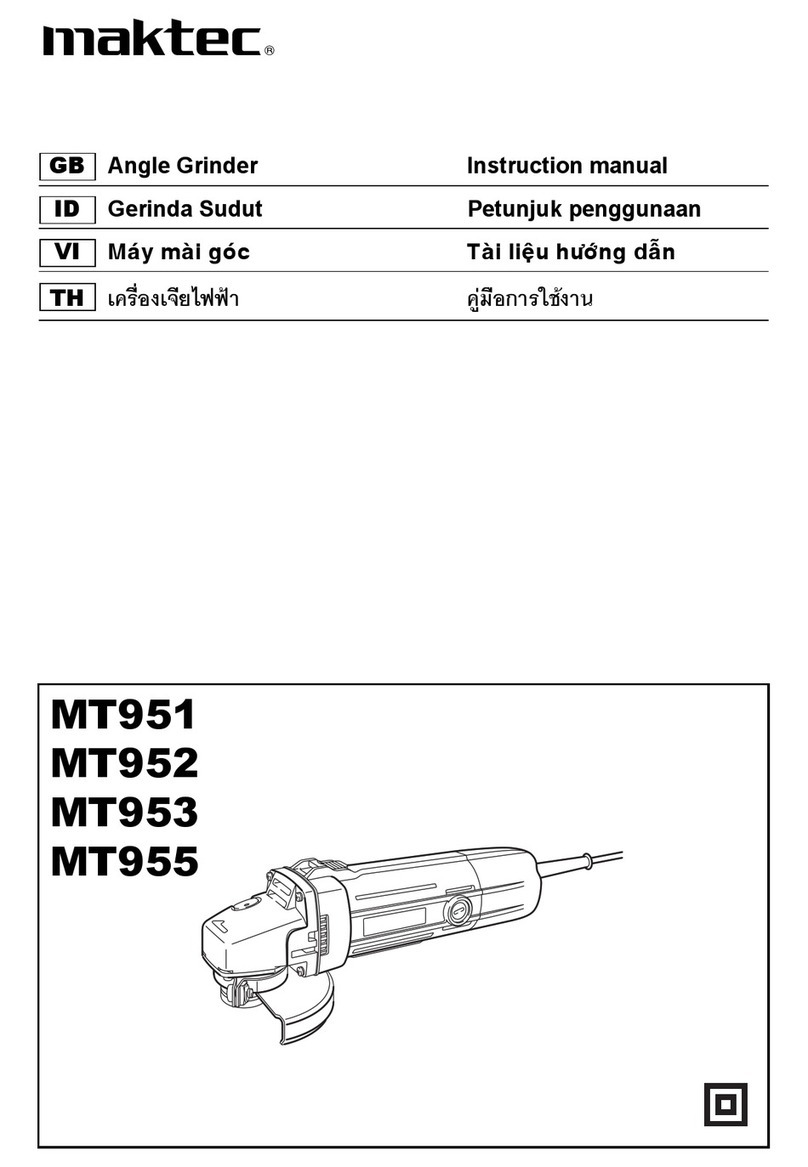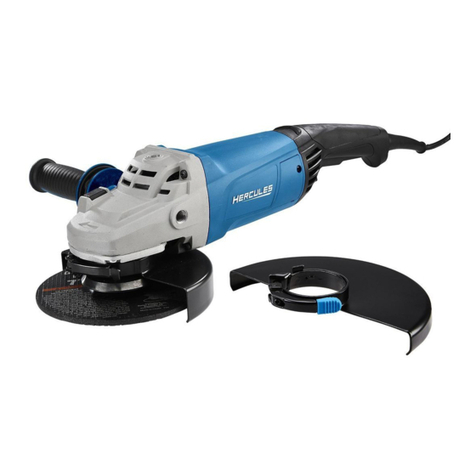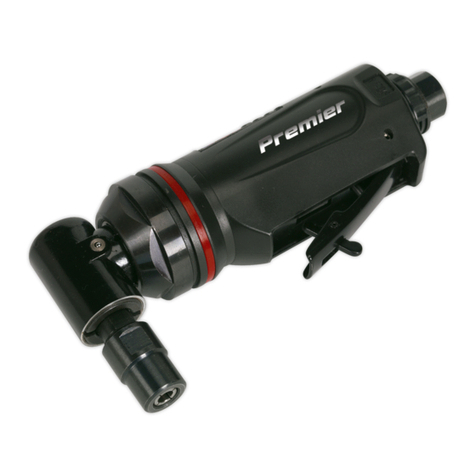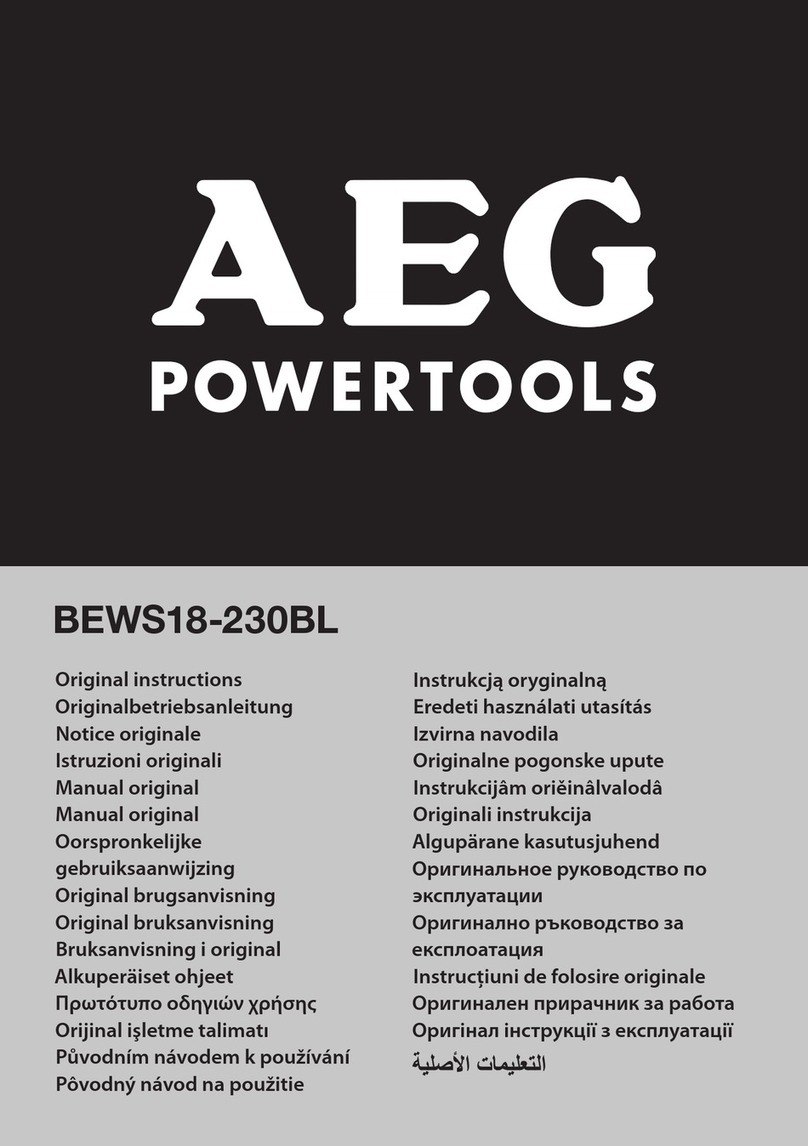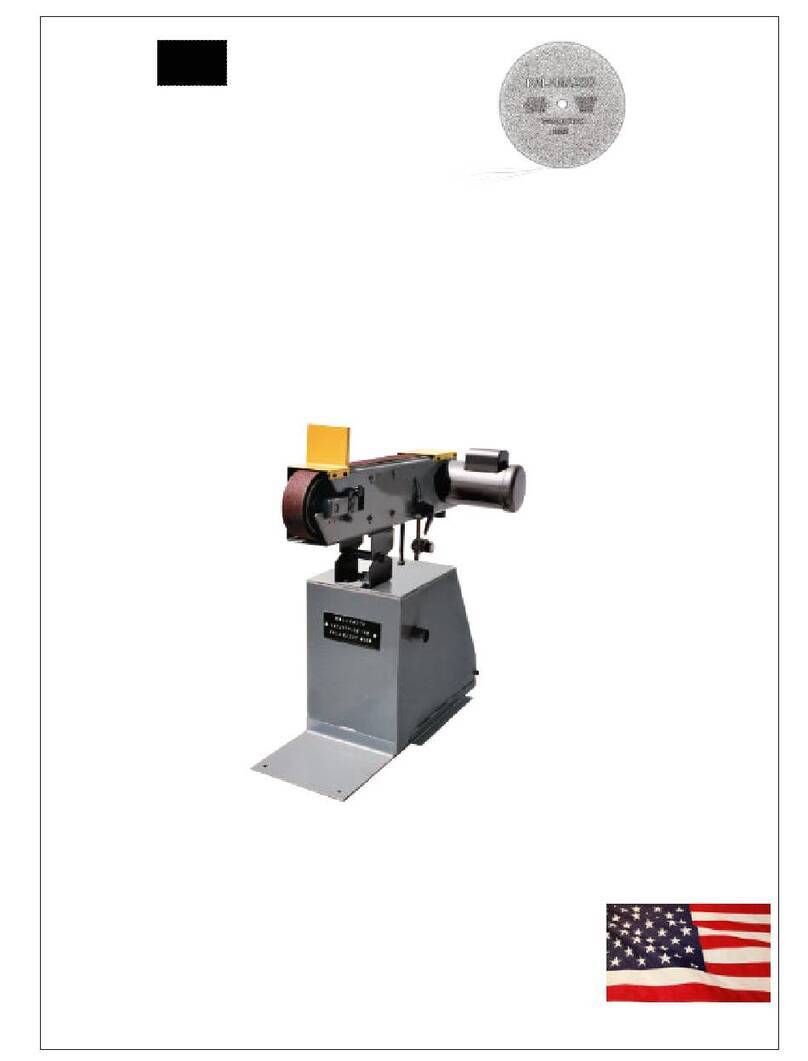Terratek TTRTK User manual

Rotary Mini Grinder
TTRTK
User Manual— Please read and retain for future reference.
IMPORTANT: Read all instructions before use.

Contents
Parts List
Parts List
Safety Instructions
Technical Information
Using your tool
Maintenance
Warranty
1
No. Description
1 Plug
2 Cord sleeve
3 Screw
4 PCB board
5 Switch
6 Screw
7 Left body
8 Stator
9 Carbon brush
10 Right body
11 Rotor
12 Spindle lock button
13 Nose cap
14 Collet
15 Collet but
16 Bearing

2
Exploded Assembly Diagram
NOTICE: Actual product may vary from pictures shown.

3
1
2
34
5
Fig.1
Fig.2
1. ON/OFF switch
2. Speed controller
3. Collet chuck nut
4. Locking knob for collet chuck
5. cover

4
Accessories list
Specification
No. Quantity Description
1 4 1/4” x 1/2” Grinding belt
2 4 1/2” x 1/2” Grinding belt
3 6 Collet (1.6, 2.4, 3.2 mm x 2)
4 1 Cutter (Ball shaped)
5 1 Cutter
6 3 HSS Drill bits ( 1.6, 2.3, 3.2mm)
7 7 Diamond-tipped cutter
8 1 Arbor for felt wheels
9 1 Arbor for grinding wheels
10 2 Grinding head for grinding belt
( 1/4”, 1/2”)
11 1 Cutting wheel with arbor
12 10 Grinding pin
13 5 Wire Brush
14 1 Polishing paste
15 2 Felt polishing Wheels (1” x 1/4”)
16 1 Fabric polishing wheel ( 1” x 1/8”)
17 1 Felt pointed polishing Wheel Pointed
( 3/8" x 3/4")
18 4 Felt polishing Wheels ( 1/2" x 1/4")
19 12 Grinding Wheel
20 2 Emery wheel
21 90 Sanding paper (180, 200 and 240 grit)
22 30 Cut Off Wheels Heavy Duty ( 0.8mm)
23 36 Cut Off Wheels Regular (0.4mm)
24 5 Cut Off Wheels Fiberglass
(1 1/4" x 3/64")
25 1 Whetstone

5
Picture No. 1
32
1
Picture No. 2
4 6
5

6
Picture No. 4
Picture No. 3
7
98 11
10

7
Picture No. 6
Picture No. 5
12
13

8
Picture No. 8
Picture No. 7
14
15 16
19
18
17
20

9
Picture No. 10
Picture No. 9
21 22 23
26
25
24

10
Technical Information
Model: TTRTK
Rated Power: 135W
No-Load Speed: 10000 - 32000/min
Chuck capacity: 3.2mm max.
NW/GW: 0.7/1.3kg
Remarking:
This mini grinder can accept the Dremel rotary tool accessories.
Read this entire manual before using this product.
Failure to do so can result in serious injury. Save this manual
for future reference.
Copyright© 2013 by ACL Group (Intl) Ltd. All rights reserved. This manual or any artwork
contained herein must not be reproduced in any shape or form without the express written
consent of ACL Group (Intl) Ltd. Diagrams within this manual may not be drawn
proportionally. Due to continuing improvements, actual product may differ slightly from the
product described herein.

11
Read and Keep This Manual
Please read carefully all instructions within this manual. Failure to follow all safety warnings
can result in serious personal injury. The term “Power Tool” in all of the following warnings
refers to your mains operated (corded) or battery operated (cordless) power tool.
This symbol is to warn you of potential personal injury
hazards. Please read carefully the notes along side this warning
to avoid possible injury or death.
Keep work area clean and well lit.
Cluttered or dark areas invite accidents.
Do not operate power tools in explosive atmospheres, such as in the presence of flammable
liquids, gases or dust. Power tools create sparks which may ignite the dust or fumes.
Keep children and bystanders away while operating a power tool. Distractions can cause you
to lose control.
Important SAFETY Information
General Safety Rules
Work area safety
WARNING! Read all instructions. Failure to follow all instructions
listed below may result in electric shock, fire and/or serious injury.
The term “power tool” in all of the warnings listed refers to corded or
cordless power tools.

12
Personal safety
Power tool use and care.
Keep your power tool clean and well serviced at all times.
Never adjust or service any power tool before disconnecting from the mains electricity supply.
Always use the correct tool for the job.
Never force the tool to work harder than it is designed to do.
Never use your power tool with broken parts such as switches, guide fences or leg stands.
ALWAYS keep your power tools away from children.
Keep cutting tools sharp to ensure less stress on the motor.
Only have your power tool serviced by a qualified repair agent using manufacturers
recommended parts.
Before use, ensure that the power outlet you are using matches the plug on your power tool
and that the voltage of the outlet matches that of your power tool.
Only use grounded extension cords with power tools fitted with 3 pin plugs and if using
outdoors ensure any extension cord is suitable for outdoor use.
Always try to avoid body contact with grounded surfaces, such as radiators, cooking ranges
and any other fixed appliance with metal surfaces.
Do not expose your power tool to wet or damp conditions and NEVER use in rain.
Check regularly the power cord of your machine and any extension cord that you are using
for damage.
Do not carry or pull the machine with the power cord.
Ensure the cord is clear from hot surfaces, oil or sharp objects.
Never use your power tool whilst under the influence of alcohol, drugs or medication.
Tiredness can often cause accidents, stay alert.
Never use your power tool without the correct guards in place.
Always use approved eye protection and dust mask. Non slip safety shoes and hearing
protectors should be worn at all times when using your power tool.
Ensure any dust collecting device supplied with your machine is connected correctly before
use.
Ensure all loose clothing, long hair or jewelry is kept clear of the machine.
Before plugging your power tool into the power outlet ensure the power tool is in the OFF
position.
Check that wrenches or adjusting keys have been removed. Any wrench or key left attached
to a moving part can result in injury.
Electrical safety

13
GENERAL SAFETY INSTRUCTIONS
Read this owner's manual completely and make sure you understand all of its safety
guidelines.
WARNING:
For your own safety read Instruction Manual before operating your power tool.
A) Wear eye protection.
B) Keep hands out of the path of cutting tools.
C) Do not operate tool without guards in place.
D) Do not perform any operation freehand.
E) Never reach around cutting tools.
F) Turn off tool and wait for cutting tools to stop before moving work piece or changing settings.
G) Disconnect power (or unplug tool) before changing cutting tools or servicing.
1. KEEP GUARDS IN PLACE
and in working order.
2. REMOVE ADJUSTING KEYS & WRENCHES.
Before turning on the power tool, make sure
the keys and adjusting wrenches have been removed.
3. KEEP WORK AREA CLEAN.
Cluttered areas and benches invite accidents.
4. ALWAYS REMAIN ALERT WHEN THE TOOL IS IN USE.
Inattention on the part of the
operator may lead to serious injury.
5. DON’T USE IN A DANGEROUS ENVIRONMENT.
Don’t use power tools in damp or wet
locations or expose them to rain. Keep work area well lit.
6. KEEP CHILDREN AWAY.
All visitors should remain at a safe distance from work area.
7. MAKE WORKSHOP CHILD-PROOF
with padlocks, master switches or by removing
starter keys.
8. USE THE RIGHT TOOL.
Don’t force a tool or attachment to do a job for which it was not
designed.
Service
Have your power tool serviced by a qualified repair person using only identical
replacement parts.
This will ensure that the safety of the power tool is maintained.
Develop a periodic maintenance schedule for your tool. When cleaning a tool be
careful not to disassemble any portion of the tool since internal wires may be
misplaced or pinched or safety guard return springs may be improperly mounted.
Certain cleaning agents such as gasoline, carbon tetrachloride, ammonia, etc. may damage
plastic parts.
When servicing a tool, use only identical replacement parts. Follow instructions in
the Maintenance section of this manual.
Use of unauthorized parts or failure to follow
Maintenance Instructions may create a risk of electric shock or injury.

14
9.
USE THE PROPER EXTENSION CORD.
Make sure your extension cord is in good
condition. When using an extension cord, be sure to use one heavy enough to carry the
current your product will draw. An undersized cord will cause a drop in line voltage resulting
in loss of power and overheating. If in doubt, use the next heavier gauge. The smaller the
gauge number, the heavier the cord.
10.
DON’T FORCE THE TOOL.
It has been designed to operate at maximum safety and
performance levels.
11.
DO NOT FORCE THE MATERIAL BEING CUT.
Always let the tool cut at its own speed.
12.
WEAR PROPER APPAREL.
Do not wear loose clothing, neckties, rings, bracelets or other
jewelry which may get caught in moving parts. Non-slip foot wear is recommended. Wear
protective hair covering if you have long hair.
13.
ALWAYS USE SAFETY GLASSES.
Also use face or dust mask for commercial cutting
operations. Everyday eyeglasses only have impact-resistant lenses, they are NOT safety
glasses.
14.
SECURE WORK.
Use clamps or a vise instead of your hand to hold work when practical.
This safetyprecaution allows for proper tool operation using both hands.
15.
DON’T OVERREACH.
Keep proper footing and balance at all times.
16.
MAINTAIN TOOLS WITH CARE.
Keep tools clean and in good working condition for
maximum safety performance. Follow instructions for lubricating and changing accessories.
17.
DISCONNECT TOOLS BEFORE SERVICING
– when changing accessories, such as
blades, bits, cutters, etc.
18.
REDUCE THE RISK OF UNINTENTIONAL STARTING.
Make sure switch is in OFF
position before plugging in.
19.
USE RECOMMENDED ACCESSORIES.
Consult the owner’s manual for recommended
accessories. The use of improper accessories may increase risk of injury.
20.
MAKE SURE YOU USE THE CORRECT TOOL
for the job you are doing.
21.
NEVER STAND ON TOOL.
Serious injury could occur if the tool is tipped or if the cutting
tool is unintentionally contacted.
22.
CHECK DAMAGED PARTS.
Before further use of the tool, damaged part(s), (i.e., guard)
should be carefully checked to determine that it will operate properly and perform its intended
function. Check for alignment of moving parts, binding of moving parts, breakage of parts,
mounting and any other condition that may affect the tools operation. A guard or other part
that is damaged should be properly repaired or replaced.
23. Replace damaged blades/cutters immediately.
DO NOT USE DAMAGED BLADES/CUTTERS.
They may cause bodily injury.
24.
DIRECTION OF FEED.
Feed work into the blade/cutter against the direction of rotation of
the blade/cutter only.
25.
DO NOT ALTER THE PLUG.

15
26.
NEVER LEAVE TOOL RUNNING UNATTENDED.
Turn power off. Don’t leave tool until it
comes to a complete stop.
27. Double Insulation eliminates the need for the three wire grounded power cord and
grounded power supply system.
This power tool is supplied with all the relevant safety guards and features, it should be
checked before every operation, this manual should be read and kept in a safe place. Whilst
we warn of all the possible risks attached to using power tools any operator must have read
and understood the manual and apply their own caution and common sense when using this
power tool.
Following this guide will greatly reduce your risk of electric shock or injury.
Only use qualified repair agents to service this power tool.
Only use qualified electrician to repair any damaged wiring.
NEVER remove the grounding prong from the power tool or extension cord.
Rotary Mini grinder
ĚĚŝƟŽŶĂůƐĂĨĞƚLJ/ŶƐƚƌƵĐƟŽŶƐ
Hold power tool by the insulated gripping surfaces, when performing an operation
where the cutting tool may run into hidden wiring.
Contact with a “live” wire will make
exposed metal parts of the tool “live” and shock the operator. Do not drill, fasten or break
into existing walls or other blind areas where electrical wiring may exist. If this situation is
unavoidable, disconnect all fuses or circuit breakers feeding this worksite.
Striking or cutting into a gas line will result in explosion. Water entering an electrical device
may cause electrocution.
Always hold the tool firmly with both hands for maximum control. Keep proper
footing and balance at all times.
This enables better control of the power tool in
unexpected situations.
Use a metal detector to determine if there are gas or water pipes hidden in the work
area or call the local utility company for assistance before beginning the operation.

16
Keep hands away from cutting area.
Do not use dull or damaged cutters.
Accessories must be rated for at least the speed recommended on the tool warning
label.
Wheels and other accessories running over rated speed can fly apart and cause injury.
Do not operate the flexible shaft with a sharp bend.
Over bending the shaft can
generate excessive heat on the jacket or hand piece. The recommended minimum is 5" radius.
Never work in area which is soaked with a liquid, such as a solvent or water, or
dampened such as newly applied wallpaper.
There is an electrical shock hazard when
working in such conditions with a power tool and heating of the liquid caused by scraping action
may cause harmful vapors to be emitted from work piece.
Always wear eye protection and a dust mask for dusty applications and when sanding.
Sanding particles can be absorbed by your eyes and inhaled easily and may cause health
complications.
Use special precautions when sanding chemically pressure treated lumber, paint that
may be lead based, or any other materials that may contain carcinogens.
A suitable breathing respirator and protective clothing must be worn by all persons entering the
work area. Work area should be sealed by plastic sheeting and persons not protected should be
kept out until work area is thoroughly cleaned.
Always wait until the machine has come to a complete stop before placing it down.
Before any work on the machine (e. g., maintenance, tool change, etc.) as well as
during transport and storage make sure the switch is off.
Unintentional actuation of the
On/Off switch can lead to injuries.
After changing the bits or making any adjustments, make sure the collet nut and
nose cap are both securely tightened.
Loose adjustment devices can unexpectedly shift,
causing loss of control, loose rotating components will be violently thrown.
Do not reach in the area of the spinning bit.
The proximity of the spinning bit to your
hand may not always be obvious.
Allow brushes to run at opera ting speed for at least one minute before using wheel.
During this time no one is to stand in front or in line with the brush.
Loose bristles or
wires will be discharged during the run-in time.
Wire and bristle brushes must never be operated at speeds greater than 15,000/min.
Direct the discharge of the spinning wire brush away from you.
Small particles and tiny
wire fragments may be discharged at high velocity during the “cleaning” action with these
brushes and may become imbedded in your skin. Bristles or wires will be discharged from the
brush at high speeds.

17
Carefully handle both the tool and individual grinding wheels to avoid chipping or
cracking. Install a new wheel if tool is dropped while grinding. Do not use a wheel
that may be damaged.
Fragments from a wheel that bursts during operation will fly away
at great velocity possibly striking you or bystanders.
Use clamps to support workpiece whenever practical. Never hold a small workpiece
in one hand and the tool in the other hand while in use. Allow for sufficient space,
at least 6", between your hand and the spinning bit.
Round material such as dowel rods,
pipes or tubing have a tendency to roll while being cut, and may cause the bit to “bite” or
jump toward you. Clamping a small workpiece allows you to use both hands to control the tool.
I
nspect your workpiece before cutting. When cutting irregularly shaped workpieces,
plan your work so it will not slip and pinch the bit and be torn from your hand
. For
example, if carving wood, make sure there are no nails or foreign objects in the workpiece.
Nails or foreign objects can cause the bit to jump.
Never start the tool when the bit is engaged in the material.
Avoid bouncing and snagging the wheel, especially when working corners, sharp
edges etc.
This can cause loss of control and kick-back.
The direction of feed with the bit into the material when carving, routing or cutting
is very important. Always feed the bit into the material in the same direction as the
cutting edge is exiting from the material (which is the same direction as the chips
are thrown).
Feeding the tool in the wrong direction, causes the cutting edge of the bit to
climb out of the work and pull the tool in the direction of this feed.
If the workpiece or bit becomes jammed or bogged down, turn the tool “OFF” by
the switch. Wait for all moving parts to stop and unplug the tool, then work to free
the jammed material.
If the switch to the tool is left “ON” the tool could restart unexpectedly
causing serious personal injury.
Do not grind or sand near flammable materials.
Sparks from the wheel could ignite these
materials.
Do not touch the bit or collet after use.
After use the bit and collet are too hot to be
touched by bare hands.
Check any parts concerned.
Clean such parts or replace them, if required.

When using the steel saws, cut off wheels, high speed cutters or tungsten carbide
cutters, always have the work securely clamped. Never attempt to hold the work
with one hand while using any of these accessories.
The reason is that these wheels
will grab if they become slight ly canted in the groove, and can kick back causing loss of
control resulting in serious in jury. Your second hand should be used to steady and guide the
hand holding the tool. When a cutoff wheel grabs, the wheel itself usually breaks. When the
steel saw, high speed cutters or tungsten carbide cutter grab, it may jump from the
groove and you could lose control of the tool.
This product is not intended for use as a dental drill, in human or veterinary
medical applications.
Serious personal injury may result.
WARNING: Some dust created by power sanding, sawing, grinding, drilling, and
other construction activities contains chemicals known to cause cancer, birth
defects or other reproductive harm. Some examples of these chemicals are:
/HDGIURPOHDGEDVHGSDLQWV
&U\VWDOOLQHVLOLFDIURPEULFNVDQGFHPHQWDQGRWKHUPDVRQU\SURGXFWVDQG
$UVHQLFDQGFKURPLXPIURPFKHPLFDOO\WUHDWHGOXPEHU
Your risk from these exposures varies, depending on how often you do this type of work.
To reduce your exposure to these chemicals: work in a well ventilated area, and work with
approved safety equipment, such as those dust masks that are specially designed to filter
out microscopic particles.
18

19
V…………………………volts
A…………………………amperes
Hz……………………….hertz
~…………………….….alternating current
…/m……………….....revolutions per minute
.....................class II construction (double insulated)
Kg………………………..kilograms
n
0
………………………..No load speed
……………….….....Conforms to European Harmonised New Approach Directives.
DC ………………..…….Direct Current
Specific Safety Rules
1)
Hold power tools by insulated gripping surfaces when performing an operation
where the cutting tool may contact hidden wiring.
Contact with a “live” wire will make exposed metal parts of the tool “live” and shock the
operator.
2)
Wear ear and eye protection.
To avoid serious injuries.
3) Be aware that this tool is always in an operating condition, since it does not have to be
plugged into an electrical outlet.
4) If the bit becomes jammed, immediately turn the trigger switch off to prevent an overload
which can damage the battery pack or motor.
5) Do not touch the rotating parts to avoid injury.
6) Do not use the tool continuously for a long period of time. Stop using the tool from time to
time to avoid overheating of the motor.
7) Do not drop the tool.
Unpacking
Carefully remove the product and any accessories from the box. Make sure that all items
listed in the packing list are included.
Symbols
IMPORTANT:
Some of the following symbols may be used on your tool.
Package contents
A) Grinder
B) 233 piece accessory kit
C) User manual
Table of contents
Other Terratek Grinder manuals

